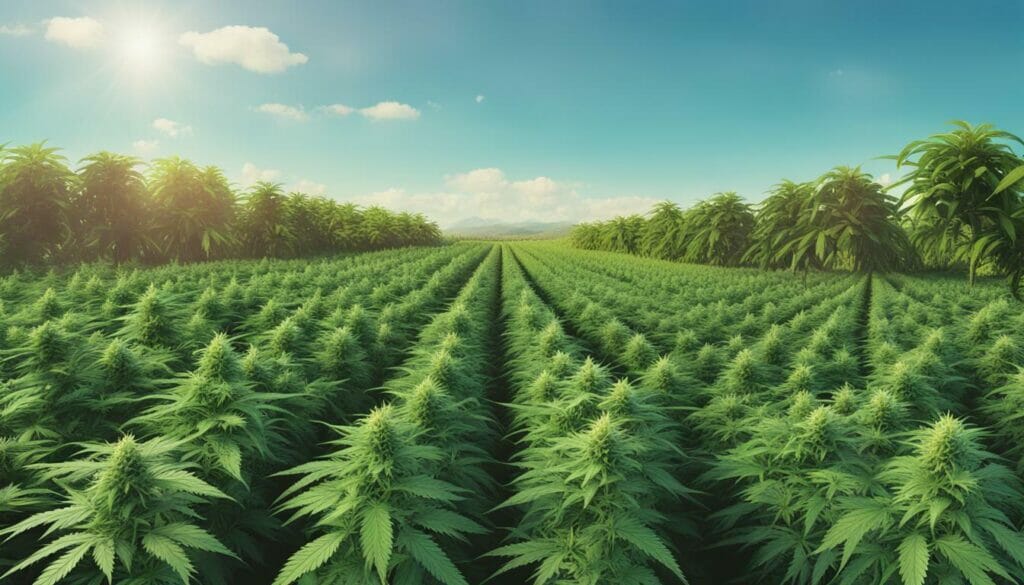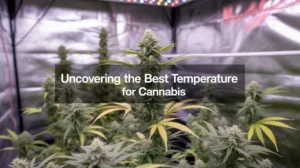Mastering Selecting Desirable Traits in Cannabis Breeding

Welcome to our article series on cannabis breeding. In this first section, we will explore the importance of selecting desirable traits in cannabis breeding.
Cannabis breeding is a complex and time-consuming process that involves selectively breeding plants to enhance desirable traits such as potency, flavor, aroma, growth patterns, and resistance to pests and diseases. By selecting desirable traits, breeders can create high-quality strains that meet the needs of consumers and the industry.
By mastering the art of selecting desirable traits in cannabis breeding, cultivators can stay ahead of the competition and create unique and sought-after strains. Let’s dive deeper into this fascinating topic.
Key Takeaways:
- Cannabis breeding involves selectively breeding plants to enhance desirable traits.
- By selecting desirable traits, breeders can create high-quality strains that meet the needs of consumers and the industry.
- Mastering selecting desirable traits in cannabis breeding is essential to stay ahead of the competition and create unique and sought-after strains.
Understanding Cannabis Genetics
Before delving into the process of selecting desirable traits in cannabis breeding, it’s important to understand the fundamentals of cannabis genetics. Cannabis strains and varieties are created through a combination of phenotypes and genotypes that determine their unique characteristics.
Phenotype refers to the observable physical traits of a plant such as its color, shape, and size. Genotype refers to the genetic makeup of a plant, including the sequence of its DNA. Together, the phenotype and genotype of a cannabis plant determine its growth patterns, potency, flavor, and aroma.
There are two main types of cannabis: Cannabis sativa and Cannabis indica. These species have distinct physical and chemical differences that have been bred over time to produce hybrid strains with desired traits. Additionally, the growing conditions in which the cannabis plant is cultivated can also affect its final characteristics.
Cannabis breeding is a complex process that involves selecting desirable traits and crossing different strains to create a unique offspring with desired characteristics. By understanding the basic principles of cannabis genetics, breeders can make informed decisions about which strains to cross and how to achieve the desired traits in their offspring.

Identifying Desirable Traits in Cannabis
When it comes to cannabis breeding, selecting desirable traits is key to creating high-quality strains that meet the needs of consumers. Breeders aim to identify and enhance specific characteristics that make a strain unique and valuable. These traits can range from physical attributes like bud appearance and plant structure, to sensory features such as flavor and aroma, to more practical aspects like yield and disease resistance.
One of the most common desirable traits that breeders target is potency. This refers to the concentration of tetrahydrocannabinol (THC), the psychoactive compound responsible for the “high” associated with cannabis use. Strains with high THC levels are often in high demand, particularly among recreational users. However, some medical cannabis patients may prefer strains with lower THC and higher levels of other compounds, such as cannabidiol (CBD), which is believed to have therapeutic benefits.
Another desirable trait is flavor. Cannabis strains can have a wide range of flavors, from fruity and sweet to earthy and spicy. The aroma of a strain can also be a factor in its desirability, as some strains have a very distinct and appealing scent.
Plant structure is also an important trait to consider. Some strains may grow tall and lanky, while others are short and bushy. Breeders may select for certain growth patterns based on factors such as the size of the grow space or the desired yield.
Finally, disease resistance is a valuable trait to target in cannabis breeding. Some strains are more susceptible to pests and diseases than others, and selecting for resistance can help to ensure a healthier crop with higher yields.
The importance of selecting desirable traits in cannabis breeding cannot be overstated. By identifying and enhancing specific characteristics, breeders can create strains that meet the needs of both consumers and cultivators.

“Selecting desirable traits is about more than just creating a popular strain. It’s about improving the overall quality of cannabis and ensuring that growers and consumers have access to the best possible product.”
Strategies for Selecting Desirable Traits
There are several strategies that cannabis breeders can use to select and enhance desirable traits in their plants. These techniques range from traditional methods such as selective breeding to more modern approaches such as genetic testing. The following are some of the most common strategies that breeders use:
Selective Breeding
Selective breeding involves choosing plants with desirable traits and crossing them with other plants that also have desirable traits. Over time, this can lead to a strain with a higher frequency of the desired trait. This method can take several generations to achieve the desired results, but it is an effective way to stabilize a particular trait.
Backcrossing
Backcrossing involves crossing a plant with one of its parents or a plant that already possesses the desired trait. This method can be used to enhance a particular trait or to remove unwanted traits from a strain. However, it can also lead to a loss of genetic diversity, which can ultimately impact the plant’s overall health and stability.
Genetic Testing
Advancements in cannabis genetics research have led to the development of genetic testing methods that can identify specific genes associated with desirable traits. This can allow breeders to select plants with those specific genes and enhance desirable traits more quickly and efficiently.

It is important for breeders to keep in mind that the selection of desirable traits can be a time-consuming and challenging process. However, by using the right strategies and techniques, breeders can create high-quality strains that meet the needs of their customers and the market.
Factors to Consider in Cannabis Breeding
Breeding cannabis plants to achieve desirable traits requires a thorough understanding of the plant’s genetics as well as careful consideration of environmental factors.
Environmental Conditions
The environment in which cannabis plants are grown can have a significant impact on the expression of desirable traits. Factors such as temperature, humidity, light intensity, and soil composition should be carefully considered when selecting parent plants and creating breeding programs.
For example, a breed focused on producing a strain with high levels of THC may require a warm, dry climate, while a strain bred for its flavor profile may require a cooler, wetter environment. By understanding the environmental preferences of a specific cannabis strain, breeders can create ideal growing conditions to maximize desirable traits.
Cultivation Techniques
The cultivation techniques used in breeding cannabis can also have a significant impact on the expression of desirable traits. Techniques such as pruning, training, and nutrient supplementation can help to control plant growth and encourage the development of specific traits.
For example, pruning can be used to promote the growth of larger buds, while training techniques such as topping and fimming can be used to increase the number of branches and flowering sites. By carefully selecting and using cultivation techniques, breeders can enhance the expression of desirable traits in their cannabis plants.
Maintaining Genetic Diversity
Maintaining genetic diversity is another important factor to consider in cannabis breeding. Over time, inbreeding and selection for specific traits can lead to a loss of genetic diversity and reduce the overall health and vigor of a strain.
Breeders can maintain genetic diversity by introducing new genetics into their breeding programs through techniques such as outcrossing and hybridization. By maintaining genetic diversity, breeders can ensure the long-term viability and health of their cannabis strains.

Overall, selecting and breeding cannabis strains with desirable traits requires a combination of careful genetic selection, environmental management, and cultivation techniques. By understanding and considering these factors, breeders can create high-quality cannabis strains that meet the needs and preferences of consumers.
Tools and Resources for Cannabis Breeders
Breeding cannabis plants with desirable traits requires a range of tools and resources. Advancements in cannabis genetics research have led to the development of new technologies that can assist breeders in optimizing their breeding programs.
DNA Sequencing: DNA sequencing is a powerful tool for identifying the genetic markers that control desirable traits in cannabis plants. This technology allows breeders to track the inheritance of specific genes and to predict the traits that will be expressed in future generations.
Genetic Databases: There are a number of genetic databases available that compile information on cannabis genetics. These databases provide useful resources for breeders, allowing them to access relevant information about different strains and their genetic makeup.
Online Communities: Online communities are an excellent resource for cannabis breeders. They provide a platform for breeders to connect with one another, share information and ideas, and collaborate on breeding projects.
The use of these tools and resources, along with a solid understanding of cannabis genetics and a commitment to selective breeding, can greatly enhance the success of a cannabis breeding program.
“The use of these tools and resources, along with a solid understanding of cannabis genetics and a commitment to selective breeding, can greatly enhance the success of a cannabis breeding program.”

Image Source: https://seowriting.ai/32_6.png
Case Studies: Successful Cannabis Breeding Projects
There have been many successful breeding projects in the cannabis industry, resulting in numerous popular strains that are highly sought after by growers and consumers alike. Let’s take a closer look at some of the most successful breeding projects and the desirable traits that were targeted.
1. Blue Dream

Blue Dream is a hybrid strain that was developed in California by crossing Blueberry with Haze. It is a well-balanced strain that gained immense popularity due to its unique flavor profile and potent effects. Breeders aimed to create a strain that was both powerful and easy to grow, with a high resistance to pests and diseases. They focused on enhancing Blueberry’s sweet, fruity taste and Haze’s cerebral effects.
| Desirable Traits | Breeding Techniques |
|---|---|
| Sweet, fruity taste | Selective breeding |
| Powerful, cerebral effects | Backcrossing |
| High resistance to pests and diseases | Genetic testing |
Blue Dream’s success can be attributed to its well-balanced characteristics, making it suitable for a wide range of consumers and growers.
2. Gorilla Glue

Gorilla Glue, also known as GG#4, is a potent hybrid strain that was developed by crossing Chem’s Sister, Sour Dubb, and Chocolate Diesel. The breeders targeted desirable traits such as its sticky, resinous buds, high THC content, and pungent aroma.
| Desirable Traits | Breeding Techniques |
|---|---|
| Sticky, resinous buds | Selective breeding |
| High THC content | Backcrossing |
| Pungent aroma | Genetic testing |
Gorilla Glue’s popularity stems from its strong and long-lasting effects, making it a popular choice for medicinal users seeking relief from pain and anxiety.
3. Pineapple Express

Pineapple Express is a hybrid strain that gained popularity after the release of the eponymous movie in 2008. It was created by crossing Hawaiian and Trainwreck strains, resulting in a sweet-tasting, uplifting strain with potent effects.
| Desirable Traits | Breeding Techniques |
|---|---|
| Sweet, tropical taste | Selective breeding |
| Uplifting, energetic effects | Backcrossing |
| Potent THC content | Genetic testing |
Pineapple Express is a popular strain among recreational users looking for a fun and energetic high.
These successful breeding projects showcase the importance of selecting desirable traits in cannabis breeding. By targeting specific characteristics and utilizing various breeding techniques, breeders can produce unique and highly sought-after strains that appeal to a wide range of consumers.
Challenges and Limitations in Cannabis Breeding
While the rewards of successful cannabis breeding are great, there are several challenges and limitations that breeders must overcome to achieve their desired results. One of the biggest challenges is genetic stability. Cannabis genetics can be highly variable, and even plants within the same strain may exhibit different traits, making it difficult to maintain consistency and predictability.
In addition, legal restrictions on cannabis can pose a challenge to breeders. In some regions, breeding cannabis may be illegal or highly regulated, limiting the ability to experiment and develop new strains. This can create significant barriers to entry for aspiring breeders and stifle innovation in the industry.
Another challenge is the time and effort required for successful breeding. Breeding cannabis is a time-consuming and labor-intensive process that requires significant patience and attention to detail. Breeders must carefully select and cross-pollinate plants over several generations to achieve the desired traits, which can take years to accomplish.
Despite these challenges, many breeders are pushing the boundaries of what is possible with cannabis genetics research, utilizing cutting-edge technology and innovative breeding techniques to create new and exciting strains. By staying up-to-date with the latest developments in the field and remaining committed to their goals, breeders can overcome these challenges and continue to push the boundaries of what is possible with cannabis breeding.

“Breeding cannabis is like a never-ending puzzle, with new challenges and opportunities arising all the time. It takes a lot of time, effort, and dedication, but the rewards are well worth it.”
Conclusion
Mastering the art of selecting desirable traits in cannabis breeding is critical to the cultivation of high-quality strains. Through an understanding of cannabis genetics and the identification of desirable traits, breeders can utilize strategies such as selective breeding and testing to enhance their plants’ features.
However, cannabis breeding also presents challenges and limitations, such as maintaining genetic stability, legal restrictions, and the time and effort required for successful breeding.
Despite these obstacles, it is important to remember the potential rewards of cannabis breeding. Successful projects have resulted in the development of highly sought-after strains, and with the help of tools and resources such as genetic databases and online communities, breeders can continue to push the boundaries of what is possible.
As you embark on your own cannabis breeding journey, remember to consider important factors such as environmental conditions and the importance of maintaining genetic diversity. By applying the knowledge gained from this article, you too can cultivate your perfect strain and contribute to the growth of the industry.
FAQ
Q: What is the importance of selecting desirable traits in cannabis breeding?
A: Selecting desirable traits in cannabis breeding is crucial for creating high-quality strains with specific characteristics such as potency, flavor, and resistance to pests and diseases. Breeders aim to enhance these traits to meet consumer preferences and improve overall cultivation outcomes.
Q: How are different cannabis strains and varieties created?
A: Different cannabis strains and varieties are created through the manipulation of genetics. Breeders use techniques such as selective breeding, backcrossing, and genetic testing to develop new combinations of desirable traits and create unique cannabis plants.
Q: What are some desirable traits that breeders aim to select in cannabis plants?
A: Breeders aim to select cannabis plants with desirable traits such as high potency, unique flavors and aromas, consistent growth patterns, and resistance to pests and diseases. These traits contribute to the overall quality and marketability of the strains.
Q: What strategies and techniques do breeders use to select desirable traits?
A: Breeders use strategies such as selective breeding, which involves choosing plants with the desired traits for reproduction. They also employ techniques like backcrossing, which involves crossing a plant with itself or a parent to reinforce specific traits. Genetic testing is another tool that helps breeders identify desirable traits at a molecular level.
Q: What factors should breeders consider when selecting and breeding cannabis plants?
A: Breeders should consider environmental conditions, cultivation techniques, and the importance of maintaining genetic diversity when selecting and breeding cannabis plants. These factors can significantly impact the expression of desirable traits and overall crop performance.
Q: What tools and resources are available for cannabis breeders?
A: Cannabis breeders have access to various tools, resources, and technologies to assist in the selection of desirable traits. These include DNA sequencing to analyze the genetic makeup of plants, genetic databases for research purposes, and online communities for knowledge sharing and collaboration.
Q: Can you provide examples of successful cannabis breeding projects?
A: There have been numerous successful cannabis breeding projects that have resulted in the development of highly sought-after strains. Examples include the breeding of strains with specific terpene profiles or high levels of cannabinoids like THC or CBD. These projects demonstrate the effectiveness of targeted breeding techniques.
Q: What are some of the challenges and limitations in cannabis breeding?
A: Cannabis breeding faces challenges such as genetic stability, where desired traits may not always be consistently expressed in subsequent generations. Legal restrictions also pose limitations, depending on the jurisdiction. Additionally, successful breeding requires significant time, effort, and expertise.
Suggested Articles
;)
;)
;)




 18 Dec 2025
18 Dec 2025  5 min read
5 min read


 December 08, 2023
December 08, 2023 


RESPONSES (0)
No responses yet. Be the first to respond!